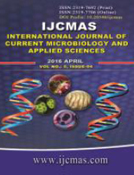


 National Academy of Agricultural Sciences (NAAS)
National Academy of Agricultural Sciences (NAAS)

|
PRINT ISSN : 2319-7692
Online ISSN : 2319-7706 Issues : 12 per year Publisher : Excellent Publishers Email : editorijcmas@gmail.com / submit@ijcmas.com Editor-in-chief: Dr.M.Prakash Index Copernicus ICV 2018: 95.39 NAAS RATING 2020: 5.38 |
A study on prevalence of malaria and typhoid fever co-infection among febrile patients was carried out in College of Health Technology Medical Centre, Calabar, Cross River State, between January and December, 2015. Venepunture technique was used for collection of the blood samples. A total of 250 patients with clinical suspicion of malaria and typhoid fever comprising of 113 males and 137 females were examined. Giemsa stained thick and thin blood films were used to detect malaria parasites in the samples. Typhoid fever was diagnosed from each sample using Widal reagents and cultural method. Out of the 250 patients, 202 (80.8%) tested positive for malaria, 117 (46.8%) tested positive for typhoid by the Widal test and 2 (0.8%) with blood culture. Males 97 (85.8%) were more infected with malaria than females 105 (76.6%) but there was no statistically significant difference (P>0.05) in the prevalence of infection while the prevalence of typhoid fever was higher in females 77 (56.2%) than males 40 (35.4%) and was statistically significant (P<0.05). 70 (28.0%) were co-infected with malaria and typhoid, out of these, 24 (21.2%) were co-infected with malaria and typhoid among the males and 46 (33.8%) were co-infected with malaria and typhoid among the females. Co-infection was highest in the age group of 1 – 15 years in both males and females. The rate of co-infection was high when typhoid fever was diagnosed by Widal (28.0%) than by blood culture method (0.8%). Thus, incidence of typhoid and malaria co-infection will greatly reduce if the diagnosis of typhoid fever in malaria endemic areas such as Calabar is based on blood culture.
 |
 |
 |
 |
 |